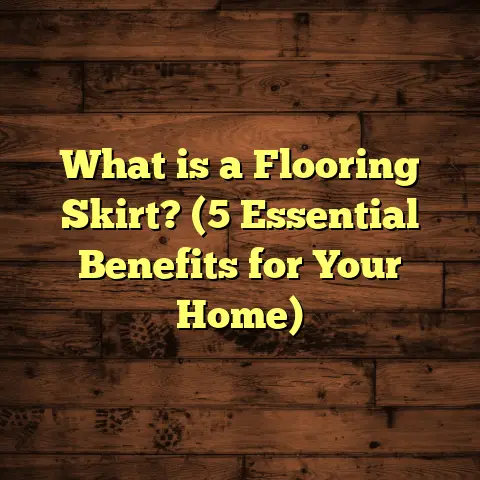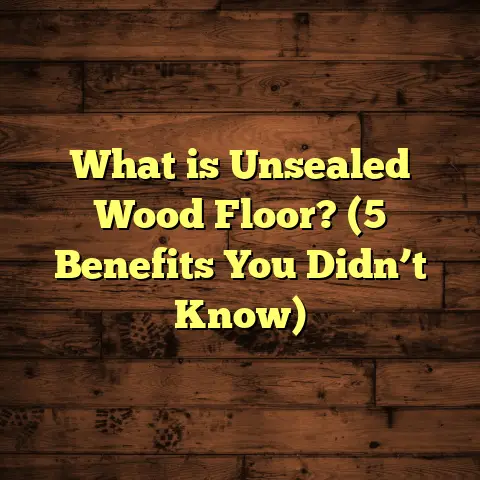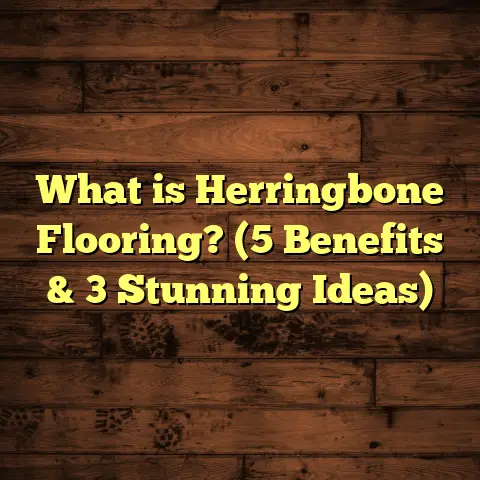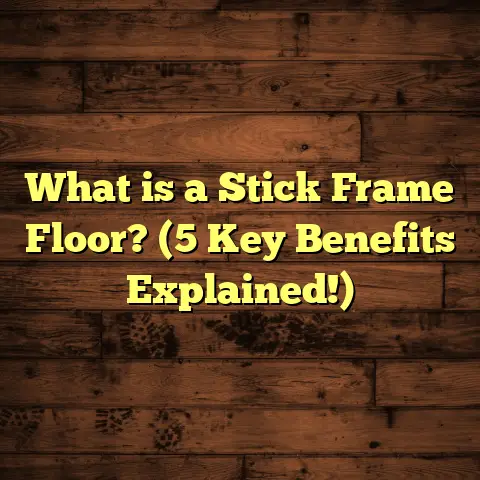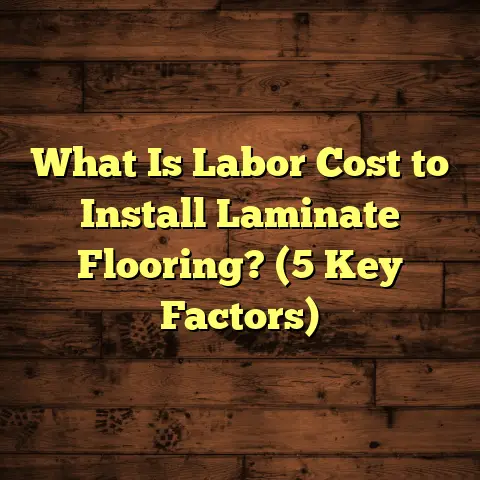What Is Cheap Wood Flooring Called? (5 Affordable Options Revealed)
What Is Cheap Wood Flooring Called?
Have you ever found yourself dreaming of that warm, inviting wooden floor beneath your feet but then felt crushed by the price tag? I’ve been there. The charm of hardwood floors is undeniable—they add character, warmth, and a timeless touch to any room. But let’s be real: solid hardwood can break the bank. Luckily, there’s a range of affordable wood flooring options out there that won’t empty your wallet but still bring that natural vibe into your home. I want to share what I’ve learned about these budget-friendly alternatives and how you can choose one that fits your style and budget.
Affordable Wood Flooring Options That Won’t Break the Bank
When people ask me, “What is cheap wood flooring called?” I usually smile because the answer isn’t just one thing. There’s a variety of budget-friendly wood flooring types, each with its own perks and quirks. Here are five affordable options you should know about—and some tips from my own projects that can help you pick the best fit.
1. Laminate Flooring — The Budget-Friendly Wood Look
Laminate flooring is probably the most popular cheap wood flooring option I see in homes and rentals. It’s made of high-density fiberboard with a photographic layer on top that mimics real wood.
Why Laminate Flooring Is So Popular
From my experience installing floors for over a decade, laminate has earned its reputation for being a solid choice when budgets are tight. You get the look of wood without paying for expensive hardwood planks. Laminate is perfect for homeowners who want style without sacrificing durability or spending a fortune.
Cost Breakdown and What You Get for Your Money
- Material cost: $1 to $3 per square foot
- Installation cost: About $1 to $3 per square foot if done by professionals
- Total for average 500 sq ft room: $1,000 to $3,000
Laminate flooring’s low price comes from how it’s made. The core is fiberboard—a compressed wood product—and the top layer is a printed image of wood grain sealed with a protective wear layer. Because it doesn’t use real wood on top, you save money but get a convincing wood look.
Personal Story: My First Laminate Installation
I remember one project where a young couple wanted to renovate their rental property quickly and cheaply between tenants. They chose laminate flooring because it was easy to install and looked good enough to attract renters. I helped lay down the planks in under two days. Months later, they told me how much easier it was to clean than carpet and how tenants loved the modern look.
Durability and Maintenance Tips
Laminate is pretty tough. It resists scratches better than hardwood thanks to its hard top layer. But it’s not indestructible—standing water or excessive moisture can cause swelling or warping.
Maintenance tips:
- Wipe up spills immediately.
- Use felt pads under furniture to prevent scratches.
- Avoid wet mopping; use a damp mop instead.
Installation Insights
The click-lock system makes laminate popular among DIYers. I’ve seen many homeowners successfully install laminate floors themselves with minimal tools and experience. Just make sure your subfloor is level and clean before starting.
2. Engineered Wood Flooring — Real Wood on a Budget
Engineered wood flooring combines a thin veneer of real hardwood on top of plywood or high-density fiberboard layers. It looks like hardwood but costs less.
Why Engineered Wood Is a Smart Choice
If you want real wood but can’t afford solid hardwood, engineered wood is the next best thing. It gives you authentic wood grain and texture without the price tag of solid planks.
How Engineered Wood Is Made
Cost Breakdown
- Material cost: $3 to $7 per square foot
- Installation cost: $3 to $5 per square foot
- Total for 500 sq ft: $3,000 to $6,000
It’s an investment but considerably cheaper than solid hardwood, which can easily tip over $10 per square foot just for materials.
Personal Experience: Helping Clients Choose Engineered Wood
A client recently wanted oak floors but had concerns about moisture from underfloor heating. We chose engineered oak as it handles temperature changes better than solid oak. The result? Gorgeous floors that stayed stable year-round.
Durability and Care
Engineered wood can be refinished if the veneer is thick enough (usually 2-4 mm). But thinner veneers can only be sanded once or twice before wearing through.
Care tips:
- Use hardwood floor cleaners designed for finished wood.
- Keep humidity levels consistent (between 30-50%).
- Avoid harsh chemicals or abrasive tools.
3. Bamboo Flooring — Sustainable and Cost-Effective
Bamboo isn’t technically wood but is often grouped with wood flooring because of its similar look and feel. It grows quickly, making it an eco-friendly choice.
Why Bamboo Is Often Overlooked but Worth Considering
Bamboo has grown in popularity thanks to its sustainability credentials. It matures in 3-5 years compared to decades for hardwood trees. If you care about the environment but want affordable floors, bamboo fits nicely.
Types of Bamboo Flooring
- Natural bamboo: Light yellowish color
- Carbonized bamboo: Darker caramel tone
- Strand-woven bamboo: Compressed fibers for extra hardness
Cost Overview
- Material: $2 to $5 per square foot
- Installation: $2 to $4 per square foot
- Total for 500 sq ft: $2,000 to $4,500
Strand-woven bamboo tends to be at the higher end due to its strength.
What I’ve Learned Installing Bamboo
I installed strand-woven bamboo for an eco-conscious client who wanted something different from traditional hardwood. The floor looked great and surprisingly held up better than some oak floors we’d done before—especially against pet scratches!
Durability Notes
Strand-woven bamboo rates around 3,000 on the Janka hardness scale (compared to 1,200 for red oak), making it one of the hardest flooring options available.
Care advice:
- Sweep regularly to avoid grit scratching.
- Use non-abrasive cleaners.
- Avoid excessive moisture.
4. Vinyl Plank Flooring With Wood Grain — Ultra-Affordable Look-Alike
Vinyl plank flooring has come a long way and now offers stunning wood grain textures that fool even trained eyes.
Why Vinyl Planks Are Worth Considering if Budget Is Tight
Vinyl plank flooring is waterproof, durable, and inexpensive. It’s a favorite for kitchens, bathrooms, basements—anywhere moisture is an issue but you want the look of wood.
How Modern Vinyl Planks Work
They’re made of PVC with a printed top layer mimicking wood grain and textures embossed into the surface for realism.
Price Breakdown
- Material: $1 to $4 per square foot
- Installation: $1 to $3 per square foot
- Total for 500 sq ft: $1,000 to $3,500
Some luxury vinyl planks (LVP) have thick wear layers for commercial-grade durability while staying affordable.
My Experience with Vinyl Plank Flooring
I installed vinyl plank floors in a basement renovation where moisture was a concern. Not only did it resist water damage perfectly, but it also looked amazing—guests were surprised it wasn’t hardwood!
Care and Maintenance
Because vinyl is waterproof:
- You can mop it without worry.
- Spot clean stains easily.
- It resists dents better than softer woods.
5. Parquet Flooring — Classic Look Without the Price
Parquet flooring consists of small wood pieces arranged in decorative patterns such as herringbone or basket weave.
Why Parquet Can Be Affordable and Stylish
Traditional parquet is often solid hardwood and expensive, but modern versions use engineered bases or laminates which bring costs down significantly.
Cost Overview
- Engineered parquet: $3 to $6 per square foot
- Laminate parquet: $2 to $4 per square foot
- Installation: $2 to $5 per square foot depending on complexity
- Total for 500 sq ft: $2,500 to $5,500
Because parquet requires more intricate installation patterns, labor may increase costs slightly.
My Parquet Project Story
I restored an older home with worn-out original parquet floors. Instead of ripping them out and installing expensive new hardwood planks, we went with pre-finished engineered parquet panels for half the cost—resulting in a beautiful classic look with budget-friendly execution.
How To Choose The Right Cheap Wood Flooring For Your Home
Ask Yourself These Questions First:
- How much foot traffic will this area see?
- Do you have pets or kids?
- Is moisture a concern (kitchen, basement)?
- Will you install yourself or hire pros?
- What’s your style preference?
Answering these helps narrow down choices quickly.
Durability vs Cost: What’s Your Priority?
If durability matters most—say you have kids or pets—laminate or strand-woven bamboo might be best. If authentic wood grain is non-negotiable but budget tight, engineered wood fits well.
Installation Tips That Save Time & Money
I’ve installed hundreds of floors myself and here are some nuggets that can help you avoid costly mistakes:
- Always measure twice before ordering materials.
- Factor in 5–10% extra material waste for cutting errors.
- Prepare your subfloor carefully; uneven surfaces cause problems.
- Use proper underlayment for moisture barriers and soundproofing.
- Take your time learning click-lock systems before DIY installation.
- Don’t forget transition strips where floors meet other surfaces.
Maintenance Advice To Keep Cheap Wood Floors Looking Great
No matter which floor you pick:
- Clean regularly with appropriate products.
- Avoid dragging heavy furniture across floors.
- Place rugs in high traffic areas.
- Maintain consistent indoor humidity levels when possible.
Real Cost Comparisons & Savings Breakdown
Here’s an expanded table comparing all five options for a typical 500 sq ft room including both material and installation:
| Flooring Type | Material Cost per Sq Ft | Installation Cost per Sq Ft | Total Cost (500 sq ft) | Durability Rating (1–10) | Water Resistance | DIY Friendly |
|---|---|---|---|---|---|---|
| Laminate | $1 – $3 | $1 – $3 | $1,000 – $3,000 | 7 | Low | Yes |
| Engineered Wood | $3 – $7 | $3 – $5 | $3,000 – $6,000 | 8 | Moderate | Moderate |
| Bamboo (Strand Woven) | $2 – $5 | $2 – $4 | $2,000 – $4,500 | 8 | Moderate | Moderate |
| Vinyl Plank (LVP) | $1 – $4 | $1 – $3 | $1,000 – $3,500 | 9 | High | Yes |
| Parquet (Engineered) | $3 – $6 | $2 – $5 | $2,500 – $5,500 | 7 | Low | No |
Frequently Asked Questions About Cheap Wood Flooring
Q: Can laminate flooring be refinished?
Nope. Once the wear layer wears off or it gets damaged, you have to replace planks since laminate can’t be sanded like real wood.
Q: How long does engineered wood last?
With proper care and if the veneer is thick enough for refinishing, engineered wood can last 20+ years.
Q: Is bamboo really eco-friendly?
Yes! Bamboo grows quickly and regenerates after harvesting without replanting.
Q: Does vinyl plank feel like real wood?
Modern luxury vinyl plank feels surprisingly close thanks to embossing techniques.
Q: What’s the easiest flooring type for DIY?
Laminate and vinyl plank flooring are the easiest thanks to their click-lock installation systems.
Final Thoughts From My Flooring Journeys
I’ve worked with countless customers who thought hardwood was out of reach financially. But after exploring laminate, engineered wood, bamboo, vinyl plank, or parquet options together, they found beautiful floors that matched their budgets and lifestyles perfectly.
If you’re dreaming of wooden floors but worried about cost, don’t give up! There’s no need to sacrifice style or quality when affordable options exist. And remember: smart installation and maintenance will keep your floors looking great for years to come.
If you want personalized advice tailored to your home or project goals, just ask—I’m happy to share what I’ve learned over thousands of square feet installed!
Would you like me to help draft step-by-step guides on installing any of these flooring types? Or maybe detail maintenance routines? Just let me know!
